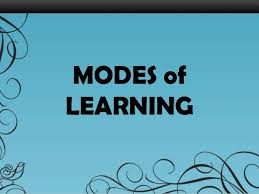Approximately 27 percent (over 5.5 million) of U.S. college students are taking at least one course online. Many mistakenly believe that all of these online courses have the same format. Technology advancements of the Digital Age have allowed online education to take several shapes. Online programs at accredited colleges could blend learning styles together to appease each student’s unique needs. One of the biggest benefits of online courses is their flexibility to train non-traditional students with the same quality curriculum at a distance. Online education is more attainable for learners who are balancing life and work too. If you’ve chosen to study online, here’s an overview on the different online learning modes you could encounter.
Asynchronous Online Courses
Fully online programs most often are delivered in an asynchronous format, which simply means learning doesn’t take place live. Asynchronous online courses don’t have set class meeting times. Instead, students are given lecture material and assignments to complete within a broad window, such as one week. Online learners can access coursework 24/7 whenever their busy schedules allow. Asynchronous learning relies heavily on email, discussion boards, and wikis to foster student connection in delayed time. Although there are syllabus deadlines, asynchronous online classes largely let students establish their own pace. Project-based majors like marketing, computer science, creative writing, and public affairs work well asynchronously.
Featured Programs
See Also: Top 30 Accredited Online Accounting College Degree Programs
Synchronous Online Courses
Synchronous literally translates to “at the same time.” Therefore, online courses in synchronous format require students do the opposite and attend live sessions. These online programs create times for professors and enrolled students to log onto the virtual classroom concurrently. Similar to webinars, synchronous online courses invite learners to interact through video conferencing, audio calls, chat rooms, and Internet podcasts. Many will require online students purchase headsets for communication via VoIP rather than simply text. Taking synchronous online courses can be more intrusive on your schedule, even though there’s no commute required. But it’s ideal for speaking-based majors like public relations, counseling, education, and Spanish.
Hybrid or Blended Courses
An alternative to fully online programs is hybrid distance learning. Hybrid learning integrates both face-to-face and online coursework to maximize peer interaction. Students pursuing hybrid or blended courses must attend on-campus residencies a few times during the semester. These campus trips could be for laboratory work, service projects, clinical practicum, or seminars. Most will be during evenings or weekends to accommodate professionals. Living near the college is important to ensure travel expenses aren’t extensive. Between the in-person meetings, students will complete class assignments online asynchronously. Blended courses are suitable for applied majors requiring practice like nursing, engineering, visual art, and social work.
Massive Open Online Courses
Online courses usually charge tuition and carry credit as their traditional counterparts do. Massive open online courses (MOOCs) are the exception. These open-enrollment courses are accessible for free by anybody with an Internet connection. MOOCs have become popular for helping students learn from elite universities without high prices. In 2015, there were over 500 colleges offering 4,200 MOOCs for 35 million students. Massive open online courses provide continuing education, but they lack transferable credit for finishing your degree. MOOC students receive content electronically and interact with hordes of diverse peers. These courses are typically presented by a higher education consortium like Coursera.
Flipped or Inverted Online Courses
During the last few years, the flipped model has been entering the online collegiate classroom. Sometimes called inverted, flipped online courses reverse what occurs during synchronous sessions. Students are given content to read and video lectures to watch individually. Then, online classes meet to focus wholly on case analysis and projects. Completing lectures as homework frees precious conferencing time for problem-solving in teams. Instructors will act as advisors to address any misconceptions from the readings. Active, student-centered learning is a major benefit from inverted courses. Online programs applying the flipped philosophy are often in mathematics, sciences, and humanities.
Web-Enhanced Courses
It’s common for prospective online students to think Web-enhanced courses belong among the above five online learning modes. However, these are just like traditional classes. Web-enhanced courses still meet on-campus at a specific location and time. The only difference is certain content components will be available online 24/7. Web-enhanced courses generally use Blackboard, Canvas, or other systems to supplement what’s learned in class. Students may post to discussion boards, review audio files, or even submit homework online. Web-enhanced courses bring technology into lecture halls to make accessing material and grades easier, but they won’t replace your physical seat time.

